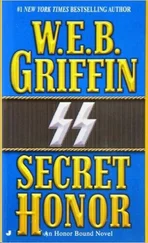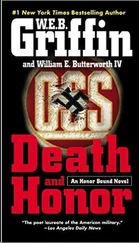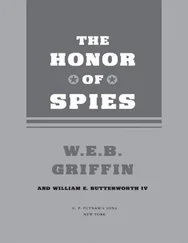Griffin W.E.B. - Honor Bound 01 - Honor Bound
Здесь есть возможность читать онлайн «Griffin W.E.B. - Honor Bound 01 - Honor Bound» весь текст электронной книги совершенно бесплатно (целиком полную версию без сокращений). В некоторых случаях можно слушать аудио, скачать через торрент в формате fb2 и присутствует краткое содержание. Год выпуска: 1993, Жанр: Старинная литература, на английском языке. Описание произведения, (предисловие) а так же отзывы посетителей доступны на портале библиотеки ЛибКат.
- Название:Honor Bound 01 - Honor Bound
- Автор:
- Жанр:
- Год:1993
- ISBN:нет данных
- Рейтинг книги:5 / 5. Голосов: 1
-
Избранное:Добавить в избранное
- Отзывы:
-
Ваша оценка:
- 100
- 1
- 2
- 3
- 4
- 5
Honor Bound 01 - Honor Bound: краткое содержание, описание и аннотация
Предлагаем к чтению аннотацию, описание, краткое содержание или предисловие (зависит от того, что написал сам автор книги «Honor Bound 01 - Honor Bound»). Если вы не нашли необходимую информацию о книге — напишите в комментариях, мы постараемся отыскать её.
Honor Bound 01 - Honor Bound — читать онлайн бесплатно полную книгу (весь текст) целиком
Ниже представлен текст книги, разбитый по страницам. Система сохранения места последней прочитанной страницы, позволяет с удобством читать онлайн бесплатно книгу «Honor Bound 01 - Honor Bound», без необходимости каждый раз заново искать на чём Вы остановились. Поставьте закладку, и сможете в любой момент перейти на страницу, на которой закончили чтение.
Интервал:
Закладка:
This document was generated by ABC Amber LIT Converter program
HONOR
BOUND
I would like to thank Mr. William W. Duffy II, of the United States Embassy in Buenos Aires, and Colonel Jose Manuel Men?ndez, Cavalry, Argentine Army, Retired, who both went well beyond the call of duty in helping me in many ways as I was writing this book.
W.E.B. Griffin
Buenos Aires 10 August 1993
Chapter One
[ONE]
Henderson Field
Guadalcanal. Solomon Islands
0645 1 October 1942
Three Grumman F4F Wildcats approached Henderson Field from the west in a shallow descent from 15,000 feet.
These three single-engine fighters represented one hundred percent of the aircraft available to Marine Fighter Squadron VMF-221which put them at thirteen planes short of the sixteen they were authorized. The Cactus Air Force, and ultimately the United States Marine Corps, obviously had to do something.
The remaining pilots of VMF-221 had heard two fairly credible rumors about what they would do.
According to the most pleasant rumor, any day now they would return to Henderson and find the taxiways and sandbag revetments crowded with sixteen glistening, new, well-maintained Wildcats of a Marine fighter squadron flown in from an aircraft carrier to replace VMF-221.
To those who desperately wished to believe this rumor, it didn't make much sense to send replacement aircraft and pilots to a squadron that had already suffered a loss of two hundred twenty percent of its original aircraft and seventy percent of its original complement of pilots. The only sensible solution was to bring in a fresh squadron.
The other theory attempted to account for the reason why VMF-221 had neither received enough aircraft and pilots to replace operational losses, nor had been relieved and replaced by a fresh Marine Fighter Squadron. According to this rumor, the plan was to replace all Marine aircraft with planes, pilots, and maintenance personnel of the U.S. Army Air Corps.
It was almost a matter of faith among Marines on Guadalcanal that somewhere in the rear areas was a vast cornucopia of U.S. Army Air Corps materiel and personnel perfectly suited for service on the island; all that had to be done to start this wealth flowing to Guadalcanal was for the Army brassin particular General Douglas MacArthurto belatedly recognize that the Army and the Marine Corps were on the same side in this war.
Those who were looking for proof of the Army Air Corps' materiel wealth and their ability to send some of it to Guadalcanal seemed to find it whenever Boeing B-17 "Flying Fortresses" huge four-engine bombers with an eight-man crewappeared at Henderson Field. The squadron of Bell P-40 fighters stationed at the field offered further proof... to those looking for it.
True, the B-17s didn't hit Japanese warships with any notable consistency, and the P-40s had arrived without the proper oxygen systems and thus couldn't operate above 12,000 feet. But that did nothing to dissuade the We Will Be Relieved By The Army Air Corps theorists of VMF-221. The B-17s bristled with .50-caliber Browning machine-gun turrets, carried 500-pound bombs, and were larger than any planes the Marines or Navy had, while the Bell fighters mounted a through-the-propeller hub cannon larger than any weapon in the Marine Corps arsenal and were more effective in a ground-support role than the Wildcats.
As soon as the big brass came to their senses and realized how the Cactus Air Force was hanging on to Henderson Field by their fingernails (just as perilously as the Marine Corps was holding on to Guadalcanal itself), a finger would be snapped and a vast aerial armada of Army Air Corps aircraft would appear. Or so went the rumor.
The leader of the three-plane flight of VMF-221 Wildcats was unconvinced by both theories. He was First Lieutenant Cletus Howell Frade, USMCR, a lankyhundred fifty-five pounds, just over six feet talldark-haired twenty-two-year-old.
Lieutenant Colonel Clyde W. Dawkins, USMC, Commanding Officer, Marine Air Group 21, had told him (and Frade believed him) that the Corps was not only fully aware that the First Marine Division and MAG-21 were indeed hanging on to Guadalcanal by their teeth, but was doing everything humanly possible to get them reinforced. With a little luck, it might be possible to find some planes somewhere, and an aircraft carrier to ferry them within flying distance of Guadalcanal. In the meantime, they would have to fight with what they had. It was not the first time in the history of the Marine Corps, Dawkins had reminded him, that Marines had been out on a limb fighting a nasty war in some miserable location without adequate supplies. And it would not be the last.
This information had led Cletus Frade to strongly suspect that he would not be going home from Guadalcanal in one piece. Or alive. The odds were against it. So far he had been lucky. Very lucky. But luck inevitably runs out. The odds increase to a point where, following the laws of probability, you lose.
He tried to avoid such thoughts, but that was impossible. So he tried to keep in mind what his uncle Jim had told him over and over: "There's no point worrying about things you can't control." Uncle Jim had raised him; but before that he'd been a Marine in France in World War I. So whenever Clete started to think about the growing probability that he would either be killed or badly injured, he tried to force his mind off the subject by imagining more attractive things.
Sometimes conjuring up the meal he intended to eat when he got home to New Orleans worked. But most often he turned to his memories of undraped female bodies. Recently, however, when he forced his mind off the unpleasant possibilities, he found himself turning more to food than to women. He supposed this was because he was undernourished and debilitated by the climate, like every other Marine on the 'Canal.
He weighed right at one-eighty when, fresh from Pensacola, he joined VMF-221in time for the Battle of Midway. On 10 August, three days after the 1st Marine Division invaded the island, he was down to one-seventy. That was the day he flew a Wildcat off the ferry-carrier USS Long Island onto the airfield the Japanese had started and the Marines had made marginally operational. This had since become famousor infamousas Henderson Field (named after a Marine aviator who'd died at Midway).
He was now down to one fifty-five. His ribs showed under skin that was dotted and pocked with the festering bites of tropical insects. When he brushed his teeth, the brush came away bloody; and his tongue could move both his incisors and some of his other teeth.
Every one of the original F4Fs was gonesome shot down in daily combat, some crashed on landing or takeoff, and some destroyed by Japanese naval artillery bombardment, or by Japanese bombers or Zeroes strafing the field. Sixteen of the original nineteen pilots were also gonesome lost in combat, some killed or injured in aircraft accidents, and three killed by Japanese twelve-inch naval artillery shellswhile they were cowering like rats in holes in the sandy soil. And gone, too, were all but three of the replacement aircraft, and many of their pilots.
It was difficult to believe that he would be luckier than the others. It was much more likely that the name Frade, Cletus H., 1/LT would appear on some After Action Report followed by the letters KIA, or MIA, or WIA (Killed I n Action, Missing I n Action, Wounded In Action).
When Henderson Field appeared below, Clete reached up and pulled his goggles down over his eyes, then looked out his open cockpit to his right, at his wingman, who three days before had reported aboard VMF-221 as a replacement pilot. The new man's eyes were on him.
Clete made two gestures: He tapped his own goggles to order the new guy to put his goggles on. After that he pointed downward, then made a circular motion, signaling that they were to make a circular descent to the airfield. The new guy, with an exaggerated bobbing of his head, signaled that he understood his orders.
Читать дальшеИнтервал:
Закладка:
Похожие книги на «Honor Bound 01 - Honor Bound»
Представляем Вашему вниманию похожие книги на «Honor Bound 01 - Honor Bound» списком для выбора. Мы отобрали схожую по названию и смыслу литературу в надежде предоставить читателям больше вариантов отыскать новые, интересные, ещё непрочитанные произведения.
Обсуждение, отзывы о книге «Honor Bound 01 - Honor Bound» и просто собственные мнения читателей. Оставьте ваши комментарии, напишите, что Вы думаете о произведении, его смысле или главных героях. Укажите что конкретно понравилось, а что нет, и почему Вы так считаете.












